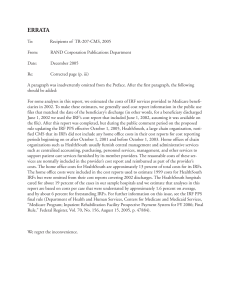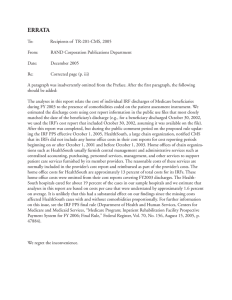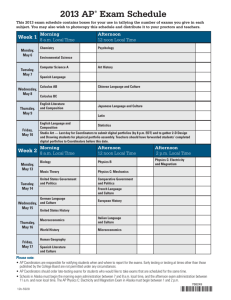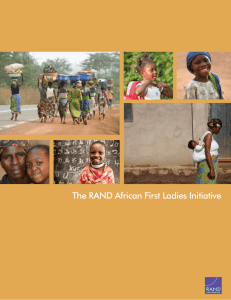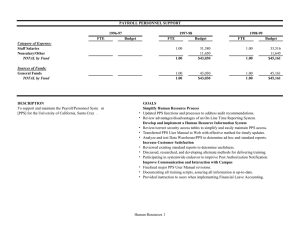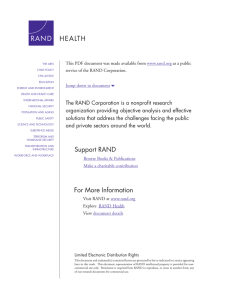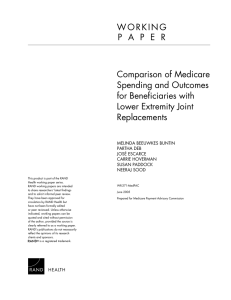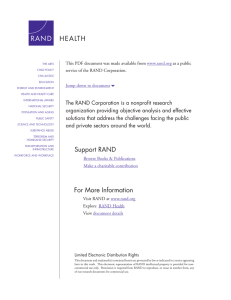6 om as a public service of the RAND Corporation.
advertisement
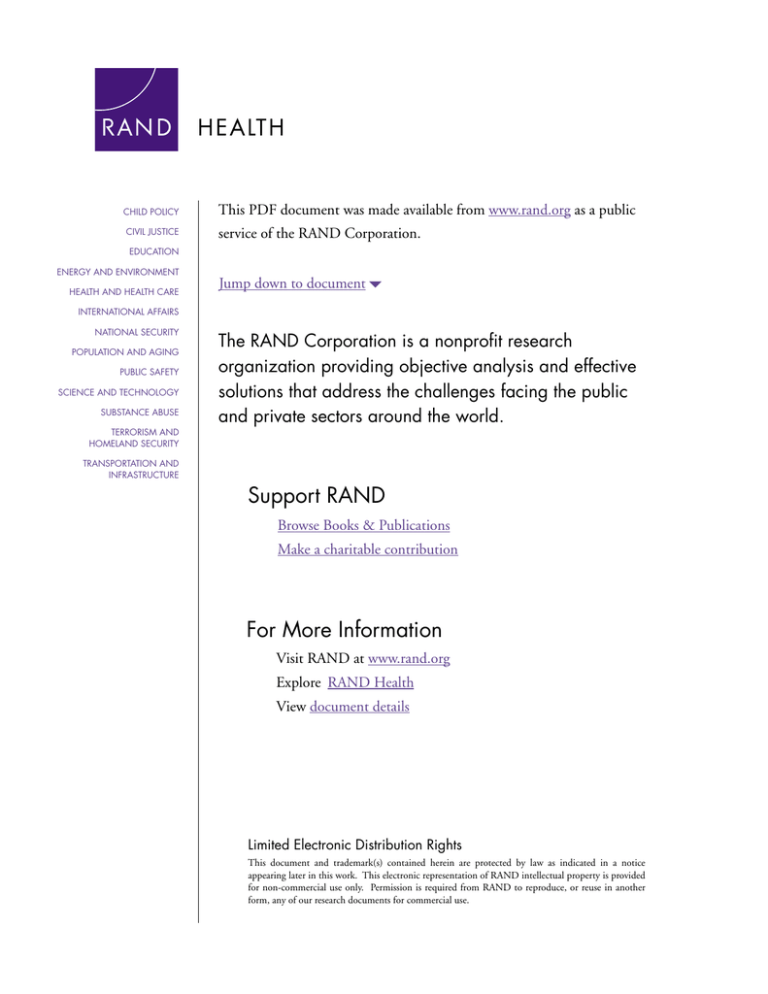
CHILD POLICY CIVIL JUSTICE This PDF document was made available from www.rand.org as a public service of the RAND Corporation. EDUCATION ENERGY AND ENVIRONMENT HEALTH AND HEALTH CARE Jump down to document6 INTERNATIONAL AFFAIRS NATIONAL SECURITY POPULATION AND AGING PUBLIC SAFETY SCIENCE AND TECHNOLOGY SUBSTANCE ABUSE TERRORISM AND HOMELAND SECURITY The RAND Corporation is a nonprofit research organization providing objective analysis and effective solutions that address the challenges facing the public and private sectors around the world. TRANSPORTATION AND INFRASTRUCTURE Support RAND Browse Books & Publications Make a charitable contribution For More Information Visit RAND at www.rand.org Explore RAND Health View document details Limited Electronic Distribution Rights This document and trademark(s) contained herein are protected by law as indicated in a notice appearing later in this work. This electronic representation of RAND intellectual property is provided for non-commercial use only. Permission is required from RAND to reproduce, or reuse in another form, any of our research documents for commercial use. This product is part of the RAND Corporation technical report series. Reports may include research findings on a specific topic that is limited in scope; present discussions of the methodology employed in research; provide literature reviews, survey instruments, modeling exercises, guidelines for practitioners and research professionals, and supporting documentation; or deliver preliminary findings. All RAND reports undergo rigorous peer review to ensure that they meet high standards for research quality and objectivity. 1PTTJCMF3FGJOFNFOUT UPUIF'BDJMJUZ-FWFM 1BZNFOU"EKVTUNFOUT GPSUIF*OQBUJFOU 3FIBCJMJUBUJPO'BDJMJUZ 1SPTQFDUJWF1BZNFOU 4ZTUFN 4VTBO.1BEEPDL(SBDF.$BSUFS #BSCBSB08ZOO"OOJF+JF;IPV 1SFQBSFEGPSUIF$FOUFSTGPS.FEJDBSFBOE.FEJDBJE4FSWJDFT 5IJT SFTFBSDI IBT CFFO TVQQPSUFE CZ UIF $FOUFST GPS .FEJDBSF BOE .FEJDBJE 4FSWJDFT $.4 VOEFS$POUSBDU/P 5IF 3"/% $PSQPSBUJPO JT B OPOQSPGJU SFTFBSDI PSHBOJ[BUJPO QSPWJEJOH PCKFDUJWF BOBMZTJT BOE FGGFDUJWF TPMVUJPOT UIBU BEESFTT UIF DIBMMFOHFT GBDJOH UIF QVCMJD BOE QSJWBUF TFDUPST BSPVOE UIF XPSME 3"/%T QVCMJDBUJPOT EP OPU OFDFTTBSJMZ SFGMFDU UIF PQJOJPOT PG JUT SFTFBSDIDMJFOUTBOETQPOTPST ¥JTBSFHJTUFSFEUSBEFNBSL ª$PQZSJHIU3"/%$PSQPSBUJPO "MMSJHIUTSFTFSWFE/PQBSUPGUIJTCPPLNBZCFSFQSPEVDFEJOBOZGPSNCZBOZFMFDUSPOJDPS NFDIBOJDBMNFBOTJODMVEJOHQIPUPDPQZJOHSFDPSEJOHPSJOGPSNBUJPOTUPSBHFBOESFUSJFWBM XJUIPVUQFSNJTTJPOJOXSJUJOHGSPN3"/% 1VCMJTIFECZUIF3"/%$PSQPSBUJPO .BJO4USFFU10#PY4BOUB.POJDB$" 4PVUI)BZFT4USFFU"SMJOHUPO7" /PSUI$SBJH4USFFU4VJUF1JUUTCVSHI1" 3"/%63-IUUQXXXSBOEPSH 5PPSEFS3"/%EPDVNFOUTPSUPPCUBJOBEEJUJPOBMJOGPSNBUJPODPOUBDU %JTUSJCVUJPO4FSWJDFT5FMFQIPOF 'BY &NBJMPSEFS!SBOEPSH EXECUTIVE SUMMARY As part of the Balanced Budget Act of 1997, the U.S. Congress mandated that the Centers for Medicare and Medicaid Services (CMS) implement a prospective payment system (PPS) for care received by Medicare beneficiaries at hospital inpatient rehabilitation facilities (IRFs). This new IRF PPS was implemented beginning on January 1, 2002. Under the new PPS, IRFs are compensated for providing inpatient rehabilitation care based on a pre-determined amount per case according to the patient’s impairment, age, level of function and co-morbid conditions. Payments to IRFs are also adjusted to account for additional costs due to certain IRF-level characteristics, namely costs due to geographic wage index differences, rural location, and low-income patients (LIPs). As part of an effort to monitor how well the IRF PPS is functioning, CMS asked RAND to examine potential refinements to the facility-level payment adjustments to improve the alignment between Medicare payments and actual hospital costs. Several developments make it likely that significant refinements can be made: x More recent data. The data used for these analyses come from calendar year (CY) 2002, while the facility adjustments are based on data from CY 1998-1999. The 2002 data therefore reflect the period during which the IRF PPS was in effect, making it advantageous to use them. x Better coding. Incentives to code comorbidities and severity more thoroughly existed in 2002 that were not present prior to the IRF PPS in 1998-1999, so the potential for different relationships between facility case mix and cost in the 2002 data exists. Similarly, the introduction of payment adjustments for facility xi characteristics could have caused IRFs to improve the accuracy of their cost report information on facility characteristics. x More complete data. Our data are more complete for these analyses than before. We now have data on 95 percent of all IRFs, versus the 60 percent we had in when initially developing the facility payment adjustments. x New data sources for imputing missing values. The identification and imputation of missing values for one of the payment variables, the low-income patient measure, has been modified given the availability of different data sources for this variable. x More accurate case mix groups. The case mix groups (CMGs) and tiers used to derive the case mix indices (CMIs) of IRFs are derived using the approach recommended by RAND’s Technical Expert Panel (TEP) in June 2004, in contrast to using the CMGs currently used in the IRF PPS. x Improved statistical approach. We have improved our statistical approach to assessing the sensitivity of the facility-level payment adjustments to unduly influential IRFs that could have unusually high (or low) costs. Our analysis aimed to assess whether the current facility-level payment adjustments are still appropriate and whether changes need to be made. Our key findings are as follows: 1) Rural and LIP adjustments are still appropriate. Using the standard linear regression approach employed last time would support a rural adjustment of 21.2 percent and a low-income adjustment of (1+LIP).616, as compared to 19.1 percent and (1+LIP).484 currently in use. While these rural and low-income adjustments are larger than those currently being used, they are statistically indistinguishable. xii 2) There is support in the data for an indirect teaching adjustment. The IRF PPS currently does not include an indirect teaching adjustment, though the acute PPS does include one. In contrast to the Phase I data, the current data show that indirect teaching is positively and significantly related to cost per case. The numeric adjustment would be (1 + interns and residents / average daily census)0.963. 3) The CMI is no longer compressed. Compression exists when IRFs with relatively high CMIs have costs that are higher relative to their CMI than hospitals with lower CMIs. The latest measure of CMI more accurately reflects resource use than it did under Phase I. 4) The wage index (WI) is still compressed. IRFs with relatively high wage index values have costs that are higher relative to their wage indices than IRFs with lower wage index values. 5) While we found evidence that an alternative model to the standard linear regression-based approach to derive facility-payment adjustments is an improvement, we did not find that the alternative method resulted in payment adjustments that were statistically significantly different from those obtained using the standard approach. In CY 2002, provider responses to the IRF PPS were not complete, as many hospitals were not on the PPS throughout the entire calendar year. Under the IRF PPS, IRFs now have incentives to code comorbidities more thoroughly. Other factors could influence the regression results as well, such as reductions in length of stay and other cost containment measures. We will therefore need to repeat the analysis using FY 2003 data before making numerical recommendations. These recommendations will xiii also depend on the decision CMS will make regarding which definitions of CMGs, tiers and relative weights to use for refinement. xiv
